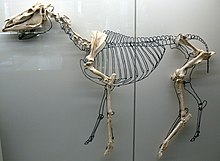| Hipparionini Temporal range: Early Miocene–Early Pleistocene PreꞒ Ꞓ O S D C P T J K Pg N | |
|---|---|

| |
| Scientific classification | |
| Domain: | Eukaryota |
| Kingdom: | Animalia |
| Phylum: | Chordata |
| Class: | Mammalia |
| Order: | Perissodactyla |
| Family: | Equidae |
| Subfamily: | Equinae |
| Tribe: | †Hipparionini Quinn, 1955 |
| Genera | |
|
See text | |
Hipparionini is a tribe of three-toed horses in the subfamily Equinae. They had body forms similar to modern equines, with high-crowned teeth. They first appeared in North America during the Early Miocene around 17 million years ago, before migrating into the Old World around 11.4-11.0 million years ago. The youngest species date to the Early Pleistocene, becoming extinct following the arrives of modern equines of the genus Equus to the Old World.
Description
Hipparionines varied widely in size, with the smallest species like Hipparion periafricanum having a body mass of only 23 kilograms (51 lb), considerably smaller than living equines, while the largest species had body masses over 300 kilograms (660 lb).
Evolutionary history
In North America, hipparionins were equally diverse to equins during the Middle Miocene but overtook them in species richness during the Late Miocene and Early Pliocene. At the end of the Hemphillian, hipparionins severely declined in diversity.
Ecology
In the Old World hipparionins were initially browsers and mixed feeders (both browsing and grazing), over time there was increasing proportion of pure grazers, though the groups ecology remained diverse, with mixed feeding being the dominant ecology during the Pliocene. Hipparionins in the western Mediterranean during the Vallesian and Turolian exhibited noticeable niche partitioning, with smaller forms being mixed feeders while larger species had more grazing diets. In contrast, contemporaneous eastern Mediterranean hipparionins did not exhibit such niche partitioning.
Taxonomy
North American genera:
- "Hipparion" (distinct from Old World species assigned to this genus)
- Neohipparion
- Pseudhipparion
- Nannippus
- Cormohipparion
Old World genera: (widely thought to descend from Cormohipparion)
- Hipparion sensu stricto
- Hippotherium
- Cremohipparion
- Sivalhippus
- Eurygnathohippus
- Plesiohipparion
- Proboscidipparion
- Shanxihippus
References
- ^ Janis, Christine M.; Bernor, Raymond L. (2019-04-12). "The Evolution of Equid Monodactyly: A Review Including a New Hypothesis". Frontiers in Ecology and Evolution. 7. doi:10.3389/fevo.2019.00119. hdl:1983/ede09e37-96f7-4baf-aec5-1bb7766a04e7. ISSN 2296-701X.
- ^ Bernor, Raymond L.; Kaya, Ferhat; Kaakinen, Anu; Saarinen, Juha; Fortelius, Mikael (October 2021). "Old world hipparion evolution, biogeography, climatology and ecology". Earth-Science Reviews. 221: 103784. Bibcode:2021ESRv..22103784B. doi:10.1016/j.earscirev.2021.103784.
- Cirilli, Omar; Pandolfi, Luca; Alba, David M.; Madurell-Malapeira, Joan; Bukhsianidze, Maia; Kordos, Laszlo; Lordkipanidze, David; Rook, Lorenzo; Bernor, Raymond L. (April 2023). "The last Plio-Pleistocene hipparions of Western Eurasia. A review with remarks on their taxonomy, paleobiogeography and evolution". Quaternary Science Reviews. 306: 107976. Bibcode:2023QSRv..30607976C. doi:10.1016/j.quascirev.2023.107976. S2CID 257594449.
- Orlandi-Oliveras, Guillem; Nacarino-Meneses, Carmen; Koufos, George D.; Köhler, Meike (2018-11-21). "Bone histology provides insights into the life history mechanisms underlying dwarfing in hipparionins". Scientific Reports. 8 (1): 17203. doi:10.1038/s41598-018-35347-x. ISSN 2045-2322. PMC 6249282.
- Hulbert, Richard C. (Spring 1993). "Taxonomic evolution in North American Neogene horses (subfamily Equinae): the rise and fall of an adaptive radiation". Paleobiology. 19 (2): 216–234. doi:10.1017/S0094837300015888. ISSN 0094-8373. Retrieved 27 November 2024 – via Cambridge Core.
- Orlandi-Oliveras, Guillem; Köhler, Meike; Clavel, Julien; Scott, Robert; Mayda, Serdar; Kaya, Tanju; Merceron, Glidas (April 2022). "Feeding strategies of circum‑Mediterranean hipparionins during the late Miocene: Exploring dietary preferences related to size through dental microwear analysis". Palaeontologia Electronica. doi:10.26879/990. Retrieved 1 January 2025 – via Palaeontologia Electronica.
| Taxon identifiers | |
|---|---|
| Hipparionini | |